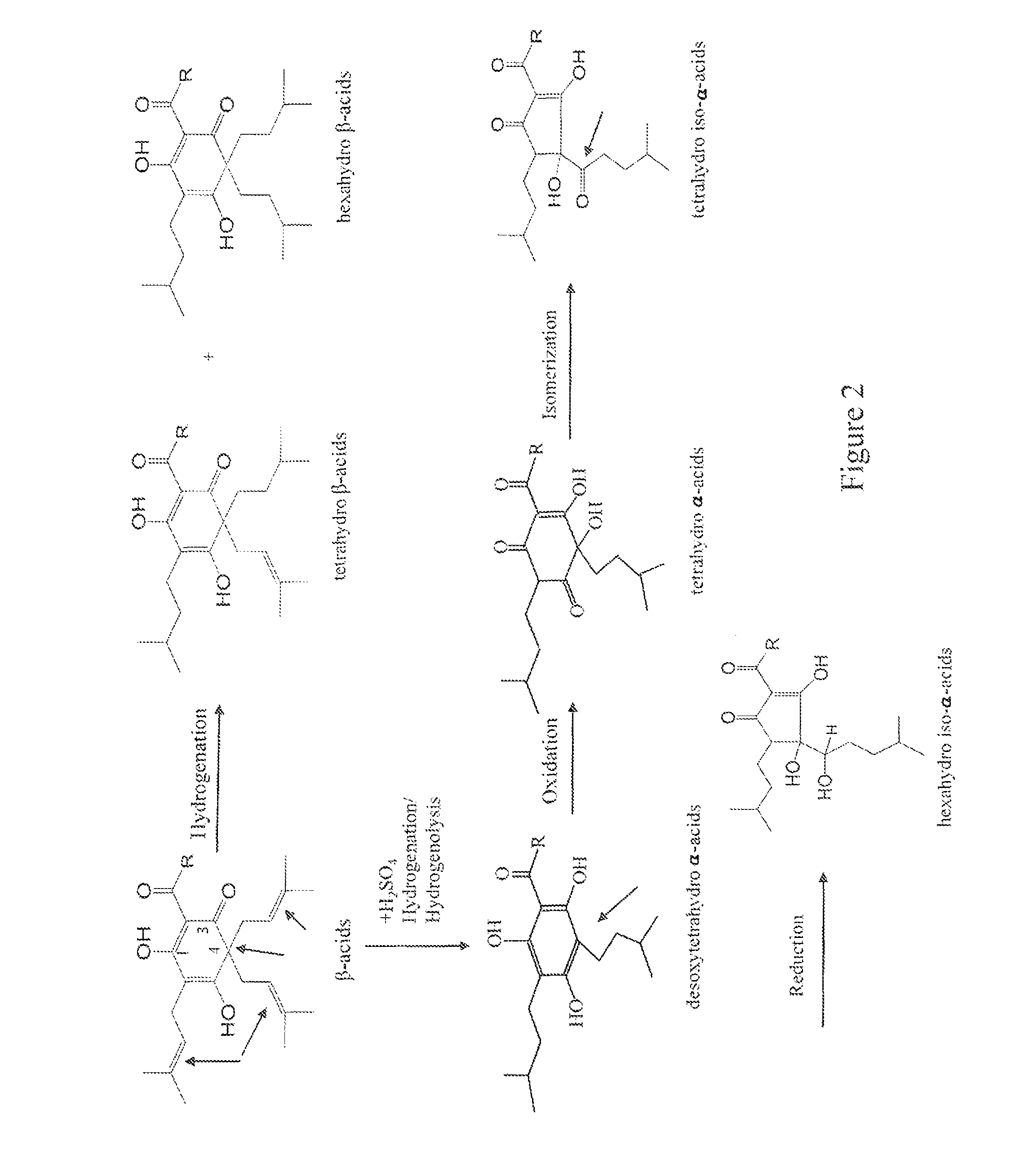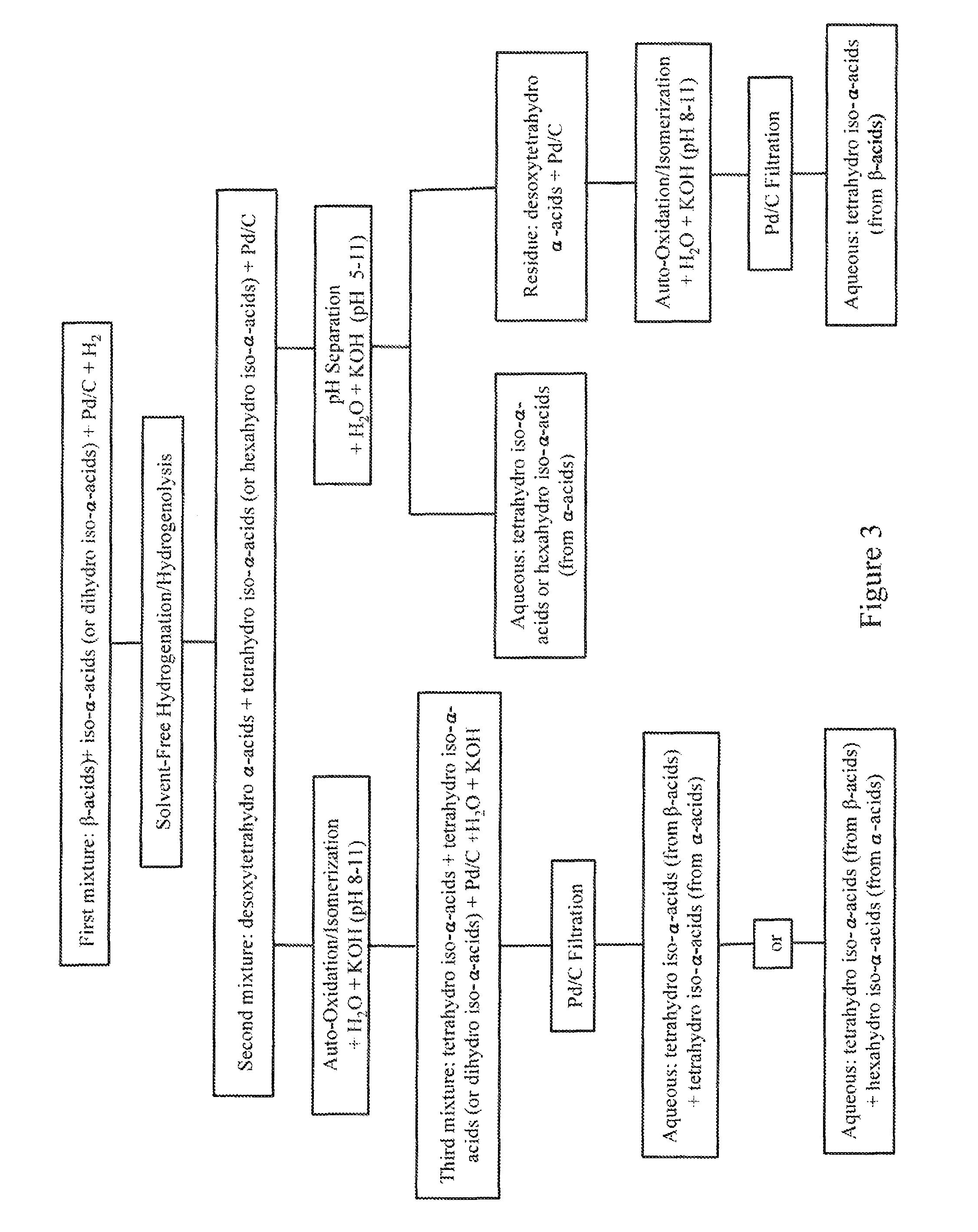Solvent-free processes for making light stable ISO-alpha-acids derivatives from both hop alpha-acids and beta-acids resins
a technology of alpha-acids and beta-acids, which is applied in the field of solvent-free processes for making light stable iso-alpha-acid derivatives from both hop alpha-acids and beta-acid resins, can solve the problems of loss of bitterness value, unstable iso--acids, and beer brewed with natural iso--acids packaged in clear or green bottles
- Summary
- Abstract
- Description
- Claims
- Application Information
AI Technical Summary
Benefits of technology
Problems solved by technology
Method used
Image
Examples
example 1
A Solvent-Free Hydrogenation of Iso-α-Acids
[0037]The autoclave was charged with 300 g of iso-α-acids resin containing 234 g of iso-α-acids (78% by high pressure liquid chromatography or HPLC) and 4.5 g of β-acids, followed by 19.72 g of 7.5% Pd / C. The mixture was stirred and heated to 60° C. Air was purged with nitrogen gas three times and replaced with hydrogen gas at 4.5 kg / cm2 (0.45 MPa). The temperature rose to 75-85° C. After 4 hours, the absorption of hydrogen ceased and the hydrogen was replaced by nitrogen gas. The reaction mixture was analyzed by HPLC. HPLC indicated that the mixture contained 66.5% tetrahydro iso-α-acids, which accounted for 228 g of tetrahydro iso-α-acids (96% yield) and small amounts of desoxytetrahydro α-acids.
example 2
A Solvent-Free Hydrogenation of β-Acids
[0038]The autoclave was charged with 183 g β-acid resin and 6.44 g of Pd / C (3.5% loading on dry basis). The mixture was purged with nitrogen gas three times followed by hydrogen gas while the vessel was agitated and heated to 65° C. The mixture was heated and maintained at 85-90° C. under the hydrogen pressure at 4.5 kg / cm2 (0.45 MPa) for 8 hours. Stopped the hydrogenation reaction. HPLC analysis indicated that the reaction failed and found no desoxytetrahydro α-acids.
example 3
A Solvent-Free Hydrogenation and Hydrogenolysis of a Mixed β-Acids and Iso-α-Acids Resin
[0039]The autoclave was charged with 159 g iso-α-acids resin (124 g and 0.35 mole of pure iso-α-acids), 66 g of pure β-acid solids (0.16 mole), and 11.28 g of 7.5% Pd / C. It was accounted for 55% iso-α-acids and 29% β-acids (w / w) in the feed resin. The mixture was purged with nitrogen gas three times followed by hydrogen gas while the vessel was agitated and heated to 60° C. The mixture was maintained at 80-90° C. under the hydrogen pressure at 4.5 kg / cm2 (0.45 MPa). After 4 hours the absorption of hydrogen ceased, the mixture was analyzed by HPLC. HPLC analysis showed that the reaction was complete and successful. The mixture was found to contain 121.4 g tetrahydro iso-α-acids (0.34 mole and 97% yield) and 33.6 g desxoytetrahydro α-acids (0.1 mole, 62% yield). The resultant mixture was oxidized and isomerized in an aqueous solution containing 31.6 g KOH, 14.8 g Mg(OH)2, and 800 mL of water with p...
PUM
| Property | Measurement | Unit |
|---|---|---|
| temperature | aaaaa | aaaaa |
| temperature | aaaaa | aaaaa |
| temperature | aaaaa | aaaaa |
Abstract
Description
Claims
Application Information
 Login to View More
Login to View More - R&D
- Intellectual Property
- Life Sciences
- Materials
- Tech Scout
- Unparalleled Data Quality
- Higher Quality Content
- 60% Fewer Hallucinations
Browse by: Latest US Patents, China's latest patents, Technical Efficacy Thesaurus, Application Domain, Technology Topic, Popular Technical Reports.
© 2025 PatSnap. All rights reserved.Legal|Privacy policy|Modern Slavery Act Transparency Statement|Sitemap|About US| Contact US: help@patsnap.com



